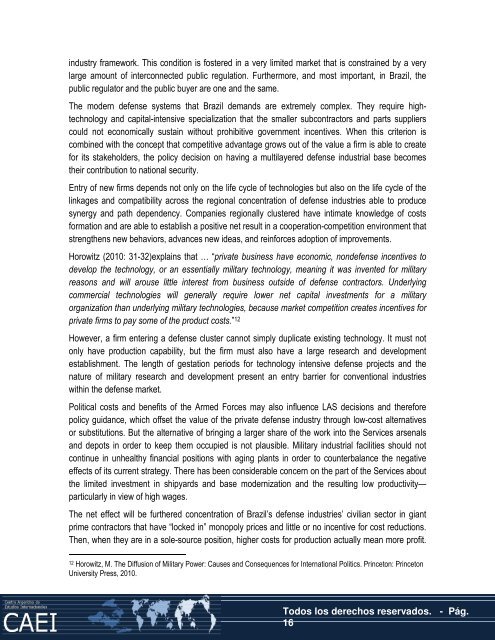Brazil's Defense Industry: The Emerging Transformational ... - CAEI
Brazil's Defense Industry: The Emerging Transformational ... - CAEI
Brazil's Defense Industry: The Emerging Transformational ... - CAEI
Create successful ePaper yourself
Turn your PDF publications into a flip-book with our unique Google optimized e-Paper software.
industry framework. This condition is fostered in a very limited market that is constrained by a very<br />
large amount of interconnected public regulation. Furthermore, and most important, in Brazil, the<br />
public regulator and the public buyer are one and the same.<br />
<strong>The</strong> modern defense systems that Brazil demands are extremely complex. <strong>The</strong>y require hightechnology<br />
and capital-intensive specialization that the smaller subcontractors and parts suppliers<br />
could not economically sustain without prohibitive government incentives. When this criterion is<br />
combined with the concept that competitive advantage grows out of the value a firm is able to create<br />
for its stakeholders, the policy decision on having a multilayered defense industrial base becomes<br />
their contribution to national security.<br />
Entry of new firms depends not only on the life cycle of technologies but also on the life cycle of the<br />
linkages and compatibility across the regional concentration of defense industries able to produce<br />
synergy and path dependency. Companies regionally clustered have intimate knowledge of costs<br />
formation and are able to establish a positive net result in a cooperation-competition environment that<br />
strengthens new behaviors, advances new ideas, and reinforces adoption of improvements.<br />
Horowitz (2010: 31-32)explains that … “private business have economic, nondefense incentives to<br />
develop the technology, or an essentially military technology, meaning it was invented for military<br />
reasons and will arouse little interest from business outside of defense contractors. Underlying<br />
commercial technologies will generally require lower net capital investments for a military<br />
organization than underlying military technologies, because market competition creates incentives for<br />
private firms to pay some of the product costs.” 12<br />
However, a firm entering a defense cluster cannot simply duplicate existing technology. It must not<br />
only have production capability, but the firm must also have a large research and development<br />
establishment. <strong>The</strong> length of gestation periods for technology intensive defense projects and the<br />
nature of military research and development present an entry barrier for conventional industries<br />
within the defense market.<br />
Political costs and benefits of the Armed Forces may also influence LAS decisions and therefore<br />
policy guidance, which offset the value of the private defense industry through low-cost alternatives<br />
or substitutions. But the alternative of bringing a larger share of the work into the Services arsenals<br />
and depots in order to keep them occupied is not plausible. Military industrial facilities should not<br />
continue in unhealthy financial positions with aging plants in order to counterbalance the negative<br />
effects of its current strategy. <strong>The</strong>re has been considerable concern on the part of the Services about<br />
the limited investment in shipyards and base modernization and the resulting low productivity—<br />
particularly in view of high wages.<br />
<strong>The</strong> net effect will be furthered concentration of Brazil’s defense industries’ civilian sector in giant<br />
prime contractors that have “locked in” monopoly prices and little or no incentive for cost reductions.<br />
<strong>The</strong>n, when they are in a sole-source position, higher costs for production actually mean more profit.<br />
12 Horowitz, M. <strong>The</strong> Diffusion of Military Power: Causes and Consequences for International Politics. Princeton: Princeton<br />
University Press, 2010.<br />
16<br />
Todos los derechos reservados. - Pág.<br />
16

















